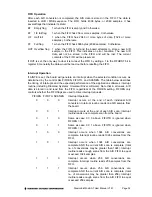
Diamond-MM-48-AT User Manual V1.01
Page 36
12. AUTOCALIBRATION OPERATION
Diamond-MM-48-AT includes a sophisticated autocalibration circuit that manages the
calibration of both the A/D and the D/A circuitry. Operation is as follows.
12.1 Reference Voltages
The board contains a precision reference voltage chip that is selected for high stability over
time and temperature. The value of the voltage output from this chip is measured at the
factory. The board also contains some precision resistor divider ladders that produce
intermediate voltages derived from the original reference. All these voltages are measured at
the factory and their values are stored in an EEPROM on the board.
12.2 A/D calibration
When the A/D is calibrated, it measures the reference voltages using an extra input
multiplexor reserved for autocalibration. The calibration software compares the actual
measurements to the stored values and makes adjustments to the board to bring the
measurements into tolerance (less than 2 LSBs max, in most cases less than 1 LSB). The
adjustments are produced by controlling several 8-bit DACs that are inserted at various
points in the circuit. The data written to these DACs is then stored in the EEPROM.
12.3 D/A Ca
l
ibration
When the D/A is calibrated, the board performs a similar operation. The output of DAC 0 is
routed through the calibration multiplexor. The offsets of the other DACs relative to DAC 0
are measured at the factory and stored in the EEPROM. During calibration the average offset
is added to the measured output of DAC 0, and this value is used as the comparison value to
minimize overall errors.
12.4 Universal Driver Software Support
Calibration is simple when using the Diamond Systems Universal Driver software. Several
functions are provided to manage the entire operation, and a demo program is included. For
application developers targeting an operating system not supported by Universal Driver, the
source code is included so you can incorporate it into your own program.
With the Universal Driver software, you have the option of recalling calibration values each
time you change the input range, or leaving the current ones in place. Leaving the current
ones in place will match the performance of other A/D boards which also use only a single
set of calibration values. Recalling the values specific to the new input range will improve
performance by a few LSBs but will result in a time delay since the data must be recalled
from the EEPROM and loaded into the DACs.
A/D and D/A maybe calibrated separately. Calibration takes a few seconds and may be
performed as often as desired, for example at system startup, once a day, etc.
NOTE:
When calibrating the D/A channels, the output voltage of DAC0 will fluctuate between
– full scale and + full-scale as part of the procedure. Any circuitry connected to the DAC
during this time may be affected and produce unwanted results.









































